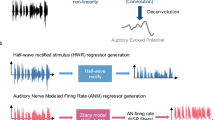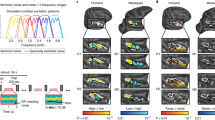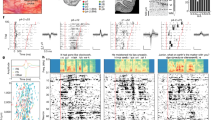Abstract
There are functional and anatomical distinctions between the neural systems involved in the recognition of sounds in the environment and those involved in the sensorimotor guidance of sound production and the spatial processing of sound. Evidence for the separation of these processes has historically come from disparate literatures on the perception and production of speech, music and other sounds. More recent evidence indicates that there are computational distinctions between the rostral and caudal primate auditory cortex that may underlie functional differences in auditory processing. These functional differences may originate from differences in the response times and temporal profiles of neurons in the rostral and caudal auditory cortex, suggesting that computational accounts of primate auditory pathways should focus on the implications of these temporal response differences.
This is a preview of subscription content, access via your institution
Access options
Access Nature and 54 other Nature Portfolio journals
Get Nature+, our best-value online-access subscription
$29.99 / 30 days
cancel any time
Subscribe to this journal
Receive 12 print issues and online access
$189.00 per year
only $15.75 per issue
Buy this article
- Purchase on Springer Link
- Instant access to full article PDF
Prices may be subject to local taxes which are calculated during checkout


Similar content being viewed by others
References
Rauschecker, J. P. & Scott, S. K. Maps and streams in the auditory cortex: nonhuman primates illuminate human speech processing. Nat. Neurosci. 12, 718–724 (2009).
Scott, S. K. & Johnsrude, I. S. The neuroanatomical and functional organization of speech perception. Trends Neurosci. 26, 100–107 (2003).
Hickok, G. & Poeppel, D. Dorsal and ventral streams: a framework for understanding aspects of the functional anatomy of language. Cognition 92, 67–99 (2004).
Sammler, D. et al. Dorsal and ventral pathways for prosody. Curr. Biol. 25, 3079–3085 (2015).
Schirmer, A. & Kotz, S. A. Beyond the right hemisphere: brain mechanisms mediating vocal emotional processing. Trends Cogn. Sci. 10, 24–30 (2006).
Zatorre, R. J., Chen, J. L. & Penhune, V. B. When the brain plays music: auditory–motor interactions in music perception and production. Nat. Rev. Neurosci. 8, 547–558 (2007).
Alain, C. et al. “What” and ‘where’ in the human auditory system. Proc. Natl Acad. Sci. USA 98, 12301–12306 (2001).
Rauschecker, J. P. Processing of complex sounds in the auditory cortex of cat, monkey, and man. Acta Otoralyngol. 532(Suppl), 34–38 (1997).
Rauschecker, J. P. & Tian, B. Mechanisms and streams for processing of “what” and “where” in auditory cortex. Proc. Natl Acad. Sci. USA 97, 11800–11806 (2000).
Rosemann, S. et al. Musical, visual and cognitive deficits after middle cerebral artery infarction. eNeurologicalSci 6, 25–32 (2017).
Kravitz, D. J. et al. A new neural framework for visuospatial processing. Nat. Rev. Neurosci. 12, 1–14 (2011).
Scott, B. H. et al. Intrinsic connections of the core auditory cortical regions and rostral supratemporal plane in the macaque monkey. Cereb. Cortex 7, 809–840 (2015).
Scott, B. H. et al. Thalamic connections of the core auditory cortex and rostral supratemporal plane in the macaque monkey. J. Comp. Neurol. 525, 3488–3513 (2017).
Scott, B. H., Malone, B. J. & Semple, M. N. Transformation of temporal processing across auditory cortex of awake macaques. J. Neurophysiol. 105, 712–730 (2011).
Arnott, S. R. & Alain, C. The auditory dorsal pathway: orienting vision. Neurosci. Biobehav. Rev. 35, 2162–2173 (2011).
Alho, K. et al. Stimulus-dependent activations and attention-related modulations in the auditory cortex: a meta-analysis of fMRI studies. Hear. Res. 307, 29–41 (2014).
Bizley, J. K. & Cohen, Y. E. The what, where and how of auditory-object perception. Nat. Rev. Neurosci. 14, 693–707 (2013).
Young, E. D. & Oertel, D. in The Synaptic Organization of the Brain (ed. Shepherd, G. M.) 125–164 (Oxford Univ. Press, 2004).
Kaas, J. H. & Hackett, T. A. Subdivisions of auditory cortex and processing streams in primates. Proc. Natl Acad. Sci. USA 97, 11793–11799 (2000).
Smiley, J. F. et al. Multisensory convergence in auditory cortex, I. Cortical connections of the caudal superior temporal plane in macaque monkeys. J. Comp. Neurol. 502, 894–923 (2007).
Hackett, T. A. et al. Multisensory convergence in auditory cortex, II. Thalamocortical connections of the caudal superior temporal plane. J. Comp. Neurol. 502, 924–952 (2007).
Warren, J. E., Wise, R. J. S. & Warren, J. D. Sounds do-able: auditory–motor transformations and the posterior temporal plane. Trends Neurosci. 28, 636–643 (2005).
Dick, F. et al. In vivo functional and myeloarchitectonic mapping of human primary auditory areas. J. Neurosci. 32, 16095–16105 (2012).
Rauschecker, J. P. Where, when, and how: are they all sensorimotor? Towards a unified view of the dorsal pathway in vision and audition. Cortex 98, 262–268 (2018).
Camalier, C. R. et al. Neural latencies across auditory cortex of macaque support a dorsal stream supramodal timing advantage in primates. Proc. Natl Acad. Sci. USA 109, 18168–18173 (2012).
Kusmierek, P. & Rauschecker, J. P. Selectivity for space and time in early areas of the auditory dorsal stream in the rhesus monkey. J. Neurophysiol. 111, 1671–1685 (2014).
Smith, E. H. Temporal processing in the auditory core: transformation or segregation? J. Neurophysiol. 106, 2791–2793 (2011).
Scott, S. K. The point of P-centres. Psychol. Res. Psychol. Forschung 61, 4–11 (1998).
Repp, B. H. & Keller, P. E. Adaptation to tempo changes in sensorimotor synchronization: effects of intention, attention, and awareness. Q. J. Exp. Psychol. A 57, 499–521 (2004).
Holcomb, P. J. & Neville, H. J. Auditory and visual semantic priming in lexical decision: a comparison using event-related brain potentials. Lang. Cogn. Process. 5, 281–312 (1990).
Hamilton, L. S., Edwards, E. & Chang, E. F. A spatial map of onset and sustained responses to speech in the human superior temporal gyrus. Curr. Biol. 28, 1860–1871 (2018).
Santoro, R. et al. Encoding of natural sounds at multiple spectral and temporal resolutions in the human auditory cortex. PLOS Comput. Biol. 10, e1003412–14 (2014).
Norman-Haignere, S., Kanwisher, N. G. & McDermott, J. H. Distinct cortical pathways for music and speech revealed by hypothesis-free voxel decomposition. Neuron 88, 1281–1296 (2015).
Evans, S. et al. The pathways for intelligible speech: multivariate and univariate perspectives. Cereb. Cortex 24, 2350–2361 (2014).
Agnew, Z. K. et al. Do sentences with unaccusative verbs involve syntactic movement? Evidence from neuroimaging. Lang. Cogn. Neurosci. 29, 1035–1045 (2014).
de Heer, W. A. et al. The hierarchical cortical organization of human speech processing. J. Neurosci. 37, 6539–6557 (2017).
Specht, K. Mapping a lateralization gradient within the ventral stream for auditory speech perception. Front. Hum. Neurosci. 7, 629 (2013).
Wagstyl, K. et al. Cortical thickness gradients in structural hierarchies. NeuroImage 111, 241–250 (2015).
Kikuchi, Y., Horwitz, B. & Mishkin, M. Hierarchical auditory processing directed rostrally along the monkey’s supratemporal plane. J. Neurosci. 30, 13021–13030 (2010).
Tuennerhoff, J. & Noppeney, U. When sentences live up to your expectations. NeuroImage 124, 641–653 (2016).
Lyu, B. et al. Predictive brain mechanisms in sound-to-meaning mapping during speech processing. J. Neurosci. 36, 10813–10822 (2016).
Leaver, A. M. & Rauschecker, J. P. Cortical representation of natural complex sounds: effects of acoustic features and auditory object category. J. Neurosci. 30, 7604–7612 (2010).
Price, C., Thierry, G. & Griffiths, T. Speech-specific auditory processing: where is it? Trends Cogn. Sci. 9, 271–276 (2005).
Beaman, C. P. & Jones, D. M. Irrelevant sound disrupts order information in free recall as in serial recall. Q. J. Exp. Psychol. A 51, 615–636 (1998).
Scott, S. K. Auditory processing — speech, space and auditory objects. Curr. Opin. Neurobiol. 15, 197–201 (2005).
Zatorre, R. J. Sensitivity to auditory object features in human temporal neocortex. J. Neurosci. 24, 3637–3642 (2004).
Evans, S. et al. Getting the cocktail party started: masking effects in speech perception. J. Cogn. Neurosci. 28, 483–500 (2016).
Meekings, S. et al. Distinct neural systems recruited when speech production is modulated by different masking sounds. J. Acoust. Soc. Am. 140, 8–19 (2016).
Brungart, D. S. et al. Informational and energetic masking effects in the perception of multiple simultaneous talkers. J. Acoust. Soc. Am. 110, 2527–2538 (2001).
McGettigan, C. & Scott, S. K. Cortical asymmetries in speech perception: what’s wrong, what“s right and what”s left? Trends Cogn. Sci. 16, 269–276 (2012).
Hickok, G. A functional magnetic resonance imaging study of the role of left posterior superior temporal gyrus in speech production: implications for the explanation of conduction aphasia. Neurosci. Lett. 287, 156–160 (2000).
Flinker, A. et al. Single-trial speech suppression of auditory cortex activity in humans. J. Neurosci. 30, 16643–16650 (2010).
Agnew, Z. K. et al. Articulatory movements modulate auditory responses to speech. NeuroImage 73, 191–199 (2013).
Jasmin, K. M. et al. Cohesion and joint speech: right hemisphere contributions to synchronized vocal production. J. Neurosci. 36, 4669–4680 (2016).
Jasmin, K. et al. Overt social interaction and resting state in young adult males with autism: core and contextual neural features. Brain 142, 808–822 (2019).
Wise, R. et al. Brain regions involved in articulation. Lancet 353, 1057–1061 (1999).
Houde, J. F. et al. Modulation of the auditory cortex during speech: an MEG study. J. Cogn. Neurosci. 14, 1125–1138 (2002).
Belyk, M. et al. The neural basis of vocal pitch imitation in humans. J. Cogn. Neurosci. 28, 621–635 (2016).
Behroozmand, R. et al. Sensory–motor networks involved in speech production and motor control: an fMRI study. NeuroImage 109, 418–428 (2015).
Takaso, H. et al. The effect of delayed auditory feedback on activity in the temporal lobe while speaking: a positron emission tomography study. J. Speech Lang. Hear Res. 53, 226–236 (2010).
Vaquero, L. et al. The left, the better: white-matter brain integrity predicts foreign language imitation ability. Cereb. Cortex 4, 2–12 (2016).
Kronfeld-Duenias, V. et al. Dorsal and ventral language pathways in persistent developmental stuttering. Cortex 81, 79–92 (2016).
Neef, N. E. et al. Left posterior-dorsal area 44 couples with parietal areas to promote speech fluency, while right area 44 activity promotes the stopping of motor responses. NeuroImage 142, 628–644 (2016).
Chevillet, M. A. et al. Automatic phoneme category selectivity in the dorsal auditory stream. J. Neurosci. 33, 5208–5215 (2013).
Markiewicz, C. J. & Bohland, J. W. Mapping the cortical representation of speech sounds in a syllable repetition task. NeuroImage 141, 174–190 (2016).
Alho, J. et al. Early-latency categorical speech sound representations in the left inferior frontal gyrus. NeuroImage 129, 214–223 (2016).
Du, Y. et al. Noise differentially impacts phoneme representations in the auditory and speech motor systems. Proc. Natl Acad. Sci. USA 111, 7126–7131 (2014).
Correia, J. M., Jansma, B. M. B. & Bonte, M. Decoding articulatory features from fMRI responses in dorsal speech regions. J. Neurosci. 35, 15015–15025 (2015).
Kanero, J. et al. How sound symbolism is processed in the brain: a study on Japanese mimetic words. PLOS ONE 9, e97905 (2014).
Agnew, Z. K., McGettigan, C. & Scott, S. K. Discriminating between auditory and motor cortical responses to speech and nonspeech mouth sounds. J. Cogn. Neurosci. 23, 4038–4047 (2011).
Krishnan, S. et al. Beatboxers and guitarists engage sensorimotor regions selectively when listening to the instruments they can play. Cereb. Cortex 28, 4063–4079 (2018).
Lewis, J. W. et al. Cortical networks representing object categories and high-level attributes of familiar real-world action sounds. J. Cogn. Neurosci. 23, 2079–2101 (2011).
Engel, L. R. et al. Different categories of living and non-living sound-sources activate distinct cortical networks. NeuroImage 47, 1778–1791 (2009).
Lewis, J. W. et al. Distinct cortical pathways for processing tool versus animal sounds. J. Neurosci. 25, 5148–5158 (2005).
Repp, B. H. & Su, Y.-H. Sensorimotor synchronization: a review of recent research (2006–2012). Psychon. Bull. Rev. 20, 403–452 (2013).
Pfordresher, P. Q. et al. Brain responses to altered auditory feedback during musical keyboard production — an fMRI study. Brain Res. 1556, 28–37 (2014).
Gaver, W. W. What in the world do we hear? An ecological approach to auditory event perception. Ecol. Psychol. 5, 1–29 (1993).
Warren, W. H. & Verbrugge, R. R. Auditory perception of breaking and bouncing events: a case study in ecological acoustics. J. Exp. Psychol. Hum. Percept. Perform. 10, 704–712 (1984).
Ortiz-Rios, M. et al. Widespread and opponent fMRI signals represent sound location in macaque auditory cortex. Neuron 93, 971–983 (2017).
Poirier, C. et al. Auditory motion-specific mechanisms in the primate brain. PLOS Biol. 15, e2001379 (2017).
Fiehler, K. et al. Neural correlates of human echolocation of path direction during walking. Multisens. Res. 28, 195–226 (2015).
Callan, A., Callan, D. E. & Ando, H. Neural correlates of sound externalization. NeuroImage 66, 22–27 (2013).
Ceravolo, L., Frühholz, S. & Grandjean, D. Proximal vocal threat recruits the right voice-sensitive auditory cortex. Soc. Cogn. Affect. Neurosci. 11, 793–802 (2016).
Ahveninen, J. et al. Evidence for distinct human auditory cortex regions for sound location versus identity processing. Nat. Commun. 4, 615–619 (2013).
Zündorf, I. C., Lewald, J. & Karnath, H.-O. Testing the dual-pathway model for auditory processing in human cortex. NeuroImage 124, 672–681 (2016).
Brungart, D. S. & Simpson, B. D. Within-ear and across-ear interference in a cocktail-party listening task. J. Acoust. Soc. Amer. 112, 2985–2995 (2002).
Phillips, D. P. et al. Acoustic hemifields in the spatial release from masking of speech by noise. J. Am. Acad. Audiol. 14, 518–524 (2003).
Mummery, C. J. et al. Functional neuroimaging of speech perception in six normal and two aphasic subjects. J. Acoust. Soc. Amer. 106, 449–457 (1999).
Cohen, L. et al. Distinct unimodal and multimodal regions for word processing in the left temporal cortex. NeuroImage 23, 1256–1270 (2004).
Scott, S. K., McGettigan, C. & Eisner, F. A little more conversation, a little less action — candidate roles for the motor cortex in speech perception. Nat. Rev. Neurosci. 10, 295–302 (2009).
Zatorre, R. J., Belin, P. & Penhune, V. B. Structure and function of auditory cortex: music and speech. Trends Cogn. Sci. 6, 37–46 (2002).
Zatorre, R. J. & Belin, P. Spectral and temporal processing in human auditory cortex. Cereb. Cortex 11, 946–953 (2001).
Poeppel, D. The analysis of speech in different temporal integration windows: cerebral lateralization as ‘asymmetric sampling in time’. Speech Commun. 41, 245–255 (2003).
Scott, S. K. et al. Identification of a pathway for intelligible speech in the left temporal lobe. Brain 123, 2400–2406 (2000).
Wise, R. J. S. et al. Separate neural subsystems within ‘Wernicke’s area’. Brain 124, 83–95 (2001).
Winer, J. A. et al. Auditory thalamocortical transformation: structure and function. Trends Neurosci. 28, 255–263 (2005).
Bizley, J. K. in Conn’s Translational Neuroscience (ed. Conn, M. P.) 579–598 (Elsevier, 2017).
Chechik, G. et al. Reduction of information redundancy in the ascending auditory pathway. Neuron 51, 359–368 (2006).
Goldstein, J. L. Auditory nonlinearity. J. Acoust. Soc. Amer. 41, 676–699 (1967).
Fuchs, P. A., Glowatzki, E. & Moser, T. The afferent synapse of cochlear hair cells. Curr. Opin. Neurobiol. 13, 452–458 (2003).
Harms, M. P. & Melcher, J. R. Sound repetition rate in the human auditory pathway: representations in the waveshape and amplitude of fMRI activation. J. Neurophysiol. 88, 1433–1450 (2002).
Purcell, D. W. et al. Human temporal auditory acuity as assessed by envelope following responses. J. Acoust. Soc. Amer. 116, 3581–3593 (2004).
Taylor, W. R. & Smith, R. G. The role of starburst amacrine cells in visual signal processing. Vis. Neurosci. 29, 73–81 (2012).
Leff, A. P. et al. Impaired reading in patients with right hemianopia. Ann. Neurol. 47, 171–178 (2000).
Coslett, H. B., Brashear, H. R. & Heilman, K. M. Pure word deafness after bilateral primary auditory cortex infarcts. Neurology 34, 347–352 (1984).
Ulanovsky, N., Las, L. & Nelken, I. Processing of low-probability sounds by cortical neurons. Nat. Neurosci. 6, 391–398 (2003).
Polterovich, A., Jankowski, M. M. & Nelken, I. Deviance sensitivity in the auditory cortex of freely moving rats. PLOS ONE 13, e0197678 (2018).
Yao, J. D., Bremen, P. & Middlebrooks, J. C. Emergence of spatial stream segregation in the ascending auditory pathway. J. Neurosci. 35, 16199–16212 (2015).
Slutsky, D. A. & Recanzone, G. H. Temporal and spatial dependency of the ventriloquism effect. Neuroreport 12, 7–10 (2001).
Chen, Y., Repp, B. H. & Patel, A. D. Spectral decomposition of variability in synchronization and continuation tapping: comparisons between auditory and visual pacing and feedback conditions. Hum. Mov. Sci. 21, 515–532 (2002).
Kaas, J. H. & Hackett, T. A. Subdivisions of auditory cortex and levels of processing in primates. Audiol. Neurotol. 3, 73–85 (1998).
Acknowledgements
During the preparation of this manuscript, K.J. was supported by an Early Career Fellowship from the Leverhulme Trust and C.F.L. was supported by an Fundação para a Ciência e a Tecnologia (FCT) Investigator Grant from the Portuguese Foundation for Science and Technology (IF/00172/2015). The authors thank J. Rauschecker and R. Wise for immensely helpful discussions of the background to many of these studies.
Reviewer information
Nature Reviews Neuroscience thanks J. Rauschecker, and the other anonymous reviewer(s), for their contribution to the peer review of this work.
Author information
Authors and Affiliations
Contributions
The authors contributed equally to all aspects of the article.
Corresponding authors
Ethics declarations
Competing interests
The authors declare that there are no competing interests.
Additional information
Publisher’s note
Springer Nature remains neutral with regard to jurisdictional claims in published maps and institutional affiliations.
Rights and permissions
About this article
Cite this article
Jasmin, K., Lima, C.F. & Scott, S.K. Understanding rostral–caudal auditory cortex contributions to auditory perception. Nat Rev Neurosci 20, 425–434 (2019). https://doi.org/10.1038/s41583-019-0160-2
Published:
Issue Date:
DOI: https://doi.org/10.1038/s41583-019-0160-2
This article is cited by
-
Dissecting neural computations in the human auditory pathway using deep neural networks for speech
Nature Neuroscience (2023)
-
Is song processing distinct and special in the auditory cortex?
Nature Reviews Neuroscience (2023)
-
Left hemispheric deficit in the sustained neuromagnetic response to periodic click trains in children with ASD
Molecular Autism (2020)
-
Cortical mechanisms of spatial hearing
Nature Reviews Neuroscience (2019)



